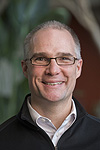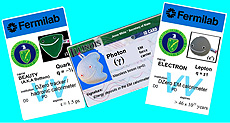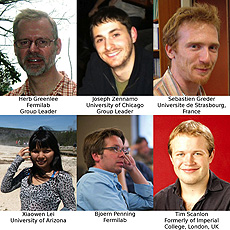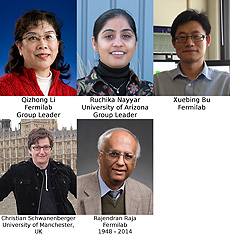|
Thursday, Feb. 20
- Breakfast: Canadian bacon, egg and cheese Texas toast
- Breakfast: sausage gravy omelet
- Chopped barbecue pork sandwich
- Smart cuisine: finger-lickin' baked chicken
- Mom's meatloaf
- Eggplant parmesan panino
- Greek chicken salad
- Meatball and orzo soup
- Chef's choice soup
- Assorted pizza by the slice
Wilson Hall Cafe menu |
|
Friday, Feb. 21
Dinner
- Roasted cherry tomato salad
- Pecan-crusted halibut with dijon cream sauce
- Wilted spinach
- Potato and onion gratin
- Lacy fruit cup with saboyan sauce
Wednesday, Feb. 26
Lunch
- Shrimp and sausage gumbo
- Mixed green salad
- Bread pudding
Chez Leon menu
Call x3524 to make your reservation.
|
|
Doug Glenzinski is new Mu2e co-spokesperson
 |
|
Doug Glenzinski
|
This month Fermilab scientist Doug Glenzinski was elected as co-spokesperson for the Mu2e experiment, an ambitious endeavor that will use muons — heavy cousins of the electron — to advance the search for new physics.
"The theory of particle physics, the Standard Model, has described decades' worth of results," Glenzinski said. "It's been a great success. But we know it's incomplete."
The Mu2e experiment will be 10,000 times more sensitive than similar experiments that have come before it. It will search for new physics in ways the LHC and neutrino experiments cannot.
"Together they'll make for a more complete picture of nature," Glenzinski said.
Glenzinski succeeds Bob Bernstein as co-spokesperson and now leads the Mu2e collaboration with Professor Jim Miller of Boston University.
Glenzinski says he's excited to be leading the experiment during these crucial months.
"Mu2e made good progress last year," he said. In 2013 Mu2e finished reference designs for two of their superconducting magnets, completed building plans, took test data using detector prototypes and added new institutions from the United States and Italy to the collaboration. And 2014 looks no less busy.
"We're all eager to hear P5's vision for the future of high-energy physics. In the meantime we're working hard to finish the experiment design," Glenzinski said. "Once that's done we'll be ready for the next phase."
If all goes according to plan, over the next year Mu2e will begin producing its superconducting wire, contract vendors to build its solenoid magnets, complete detector R&D and break ground for a new building to house the experiment.
"This should be a big year for us," he said. "The whole collaboration is excited and ready to start building."
—Leah Hesla
|
Presentation template, letterhead available
A new Fermilab presentation template and updated letterhead are available for download from the Fermilab Graphics Standards website. Employees are encouraged to use the new template and letterhead when representing the laboratory to external organizations.
PC and Mac installation and usage instructions are also available for the PowerPoint template. They cover using the template file to create new presentations, choose slide layouts, edit the footer, and select recommended colors and fonts.
Questions can be directed to Katie Yurkewicz in the Office of Communication.
|
In memoriam: Rick St. Denis
 |
|
Rick St. Denis
|
University of Glasgow professor and Fermilab user Rick St. Denis passed away on Feb. 15 after a six-month battle with cancer.
St. Denis completed his graduate work on the first run of CDF at Fermilab. He then moved to ALEPH and was involved in the early designs of the toroidal muon system for ATLAS. He returned to CDF to work on Higgs searches and more recently became deeply involved in the top-Higgs analysis at ATLAS.
The family of St. Denis will hold a small, private funeral on Feb. 21. They request that donations in St. Denis' memory be made to Marie Curie Cancer Care.
|
Smashing through the snow
 |
| Gordon Garcia of Bartlett, Ill., caught on camera this coyote wading through the knee-high snow on Saturday.
Photo: Gordon Garcia |
|
Could sterile neutrinos solve the cosmological mass conundrum?
From Physics World, Feb. 18, 2014
Scientists know that when they measure the total amount of matter in the universe using two competing methods, one will give a higher value for the total density of matter than the other. To resolve this measurement discrepancy, two separate research groups have now proposed that the missing mass might be in the form of neutrinos. Accurately measuring the total amount of matter in the universe is a crucial cosmological parameter for interpreting a vast number of astrophysical phenomena.
Read more
|
CERN considers building huge physics machine
From BBC News, Feb. 18, 2014
The possibility of building an underground "atom-smasher" four times the size of the Large Hadron Collider is to be explored by experts.
The decision follows a high level meeting of scientists last week in Geneva, near the European particle physics center, CERN.
The proposal is for a 100-km tunnel which would encircle the Swiss city.
It would reach to the Alps in the east, the Jura mountains in the west and even go under Lake Geneva.
Maps showing the proposed route reveal that it dwarfs the existing LHC, which is itself a world record beater as a science facility.
Read more
|
|
Particle ID required
 |
| Identifying the specific types of particles in the DZero detector is absolutely crucial for performing measurements and searches. Different particles have characteristic signatures when interacting with the detector material, which allow them to be differentiated, as described in two recent DZero papers. |
Disponible en español
What does an electron look like in the DZero detector? Or what about a bottom quark? Or even a photon? Answering such questions is a crucial part of any particle physics measurement. For a given process of interest, there is a distinct set of decay products. For example, single top quark production may be characterized by two bottom quarks, an electron and a neutrino. To select such events, we need to identify these various final-state particles in the detector. The performance of such "particle ID" feeds directly into the sensitivity to rare processes and the precision when measuring fundamental parameters.
The DZero collaboration recently submitted two publications describing different types of particle ID. The first paper covers the identification of photons, electrons and positrons (anti-electrons), or EM-ID for short, since all these particles interact through the electromagnetic (EM) force in the calorimeter detector. The second paper describes the identification of bottom quarks (b-ID), in particular the tools used to distinguish them from lighter quarks. While the specific techniques are quite different in the two papers, the overall strategies are very similar.
The first step is to design an algorithm that differentiates between the particle of interest and the relevant backgrounds. The algorithm relies on the fact that different particles interact with the detector in different ways, leading to distinct experimental signatures. For example, both photons and electrons tend to deposit their energy in the inner layers of the calorimeter, as distinct from quark jets, which penetrate farther. Similarly, jets from bottom quarks tend to originate farther from the original proton-antiproton collision than light-quark jets, due to the relatively long bottom quark lifetime. For both papers, scientists use multivariate techniques to combine several discriminating variables, giving a single output number that expresses the confidence in the identification.
The next step is to quantify the performance of the ID algorithm. Specifically, for a given value of the output, we need to know the efficiency of identifying the desired particle, as well as the rate of false positives (or "fakes"). The usual strategy is to use control samples with a well-known composition. For instance, a very pure electron sample can be collected from Z boson decays into an electron-positron pair, allowing the efficiency of electron ID to be extracted as a function of various properties of the particle. Similarly, a sample dominated by light quark jets allows the fake rate of the b-ID algorithm to be extracted.
The two papers represent the culmination of years of gradual improvements, testimony to the innovation and hard work of many DZero members. The resulting gains in ID performance feed directly into the analysis program, giving more precise measurements and more sensitive searches. As a particular (and timely!) example, the observation of single top quark production in the s-channel, one of the rarest of Standard Model processes, is now within reach at the Tevatron, something that would not have been possible without these state-of-the-art particle ID tools. The combination of the Tevatron experiments' results on s-channel single top quark production will be presented at the wine-and-cheese seminar tomorrow at 4 p.m., so please come along to learn more.
—Mark Williams
 |
| These DZero members all made significant contributions to the b quark identification paper. |
 |
| These DZero members all made significant contributions to the EM-ID paper. We recognize the major contributions of Rajendran Raja (1948-2014) over the course of both Run I and Run II to DZero electron and photon identification, including contributions to the NIM paper submitted on Dec. 30, 2013. |
|
|